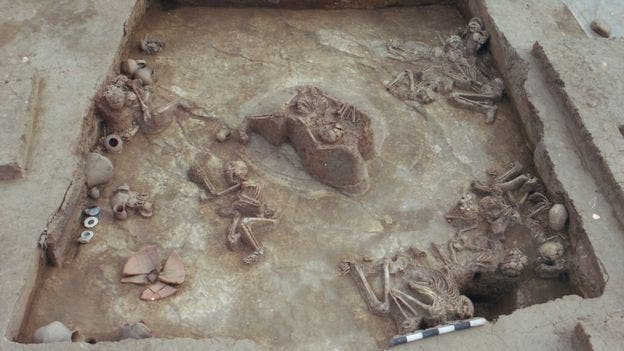
Sometimes the line between fable and history gets blurred. Such is the case of the founding of China’s mythical first dynasty 4,000 years ago.
Around that time, legend has it a great flood of Biblical proportions swept the Yellow River basin, but a local hero named Yu, 8th great-grandson of the Yellow Emperor and son of Gun who unsuccessfully tried to control the frequent flooding, changed everything. Learning from his father’s mistakes and with the aid of skilled engineers, over the course of thirteen years Yu made a system of irrigation canals which relieved floodwater into fields, instead of damming the river flow as his forebearers. This not only vastly brought prosperity to his people whose agriculture flourished, but also dredged the silty beds of the rivers. Yu The Great, as he was to be remembered, went on to set up a dynastic rule in China.
Once thought a mere legend, now a scientific fact
There’s no doubt that this story is of great appeal, as is often the case with “people’s savior” motifs, but for years scholars have debated which parts of this story belong to historicity and which belong to myth. The fabled flood, at least, was very much real and it seems like what little historical accounts we have of this event were no exaggerations, a groundbreaking study made by Chinese scientists concludes.
“It’s very difficult to ever actually prove the origin of pre-written history events. But they’ve made a very interesting case, that I’m sure geologists will continue to poke at, and investigate, and argue about – because that’s what we do,” Prof David Montgomery of the University of Washington, who was not involved in the research, commented for the BBC.
“But the cultural connection – possibly explaining the origin of the Chinese flood story – is too intriguing to ignore.”
Led by Qinglong Wu at Peking University, China, the researchers gathered an immense body of evidence to support their claim, including ancient sediments, skeleton remains from caves, geological “footprints”, as well as modern geophysical readings.

This investigation is ten years in the making. In 2007, the Chinese researchers found evidence of an earthquake that struck the area surrounding the Jishi Gorge at the upper reaches of the Yellow River, some 1,300 kilometers west of Beijing. The event triggered a massive landslide which blocked the flow of the Yellow river with a dam of rock and dirt.
[panel style=”panel-info” title=”Did you know? ” footer=””]The Yellow River actually gets its name from the huge amounts of yellow loess silt that it contains, which often gives the river a distinctive yellow color. The problem with a river containing large amounts of silt and sediment is that it tends to build up along the banks and other slow-moving areas. In addition to flooding, this can eventually cause the river to change its course as well.[/panel]
This natural dam stood for almost half a year, and when it broke it released a massive flood gate. Sampling sediments from the origin (the lower part of the ancient dam was still buried beneath the river to this day), to as far as 25 kilometers from the gorge Wu and colleagues found via radiocarbon dating that a thick layer of mud had swept a vast area, engulfing settlements, caves and an untold number of victims. Settlements even a thousand kilometers downstream would have been likely flooded by this massive event.
“The earthquake and flood must have occurred in the same year,” says Darryl Granger, a geologist at Purdue University in West Lafayette, Indiana, who is a co-author of the paper.
“It’s among the largest known floods to have happened on earth during the past 10,000 years. And it’s more than 500 times larger than a flood we might expect on the Yellow River from a massive rainfall,” Granger added.
“It’s an amazing story of all these different lines of evidence coming together,” Cohen says. “If the great flood really happened, then the Xia dynasty likely happened, too,” he concludes.
To this day, despite modern dams and irrigations, the Yellow River still causes big floods. In fact, the 1931 Yellow River flood is considered the worst in history. Nobody knows for sure, but most accounts seem to agree that around 3.7 million people were killed and 50 million were turned into refugees after an 110,000 square kilometers region was inundated.



